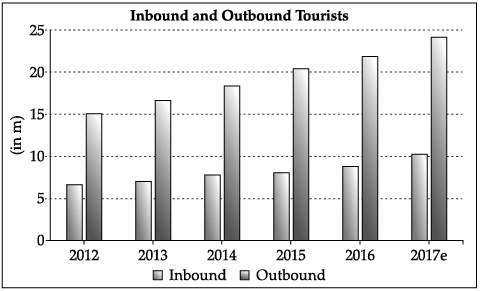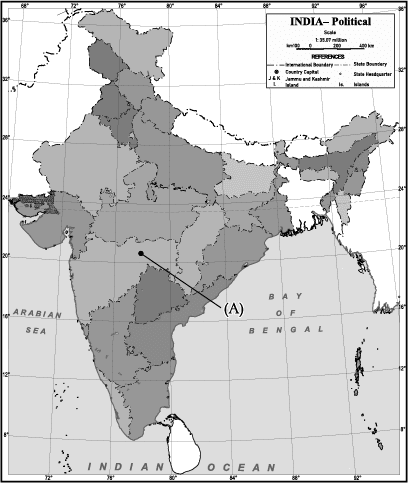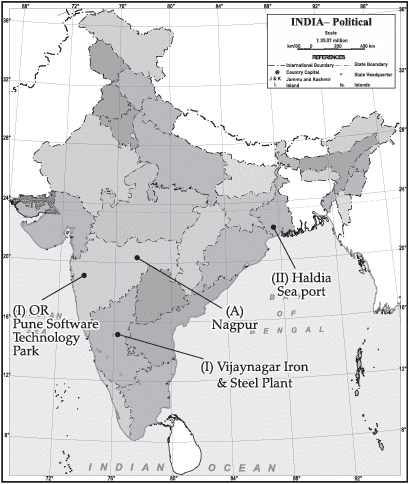Class 10 Social Science: CBSE Sample Question Paper- Term II (2021-22) - 3 | Social Studies (SST) Class 10 PDF Download
| Table of contents |

|
| Class-X |

|
| Time: 120 |

|
| Minutes |

|
| M.M: 40 |

|
| Section - A |

|
| Section - B |

|
| Section - C |

|
| Section - D |

|
| Section - E |

|
Class-X
Time: 120
Minutes
M.M: 40
General Instructions:
Read the following instructions very carefully and strictly follow them:
- This Question paper is divided into five sections-Section A, B, C, D and E.
- All questions are compulsory.
- Section-A: Question no. 1 to 5 are very Short Answer type questions of 2 marks each. Answer to each question should not exceed 40 words.
- Section-B: Question no. 6 to 8 are Short Answer type questions, carrying 3 marks each. Answer to each question should not exceed 80 words.
- Section-C: Question no. 9 and 10 are long Answer type questions, carrying 5 marks each. Answer to each question should not exceed 120 words.
- Section-D: Question no. 11 and 12 are Case Based questions.
- Section-E: Question no. 13 is map based, carrying 3 marks with two parts, 13.1 from History (1 mark) and 13.2 from Geography (2 marks).
- There is no overall choice in the question paper. However, an internal choice has been provided in a few questions. Only one of the choices in such questions have to be attempted.
- In addition to this, separate instructions are given with each section and question, wherever necessary.
Section - A
Q.1. Describe the role of ‘Jobbers’ in the beginning of 20th century in India.
Role of Jobbers:
Industrialists usually employed jobbers to get new recruits. They became persons with some authority and power. They were old and trusted workers. They got people from their villages. They ensured them jobs. They helped them to settle in the city. They also provided them money in times of crisis.
Q.2. Classify industries on the basis of ownership and give one example of each category.
Classification of industries on the basis of ownership:
(i) Public Sector Industries: BHEL, SAIL, etc.
(ii) Private Sector Industries: TISCO, Bajaj Auto Ltd.
(iii) Joint Sector Industries: Oil India Ltd.
(iv) Cooperative Sector Industries: Sugar Industry in Maharashtra; AMUL, etc.
Q.3. What are the expected outcomes of Democracy? Explain.
The expected outcomes of democracy are as follows:
(i) A government that is chosen and accountable to the people is called a Democratic government.
(ii) A government that is responsive to the needs of the people.
(iii) Economic growth and development reducing all forms of Inequality and end of Poverty.
Q.4. Which type of deposits with the banks are called Demand Deposits? State any one important feature of Demand Deposits.
A demand deposit account is a bank account where you can withdraw any time you want, without paying any additional charges for it.
Its important features are:
(i) Banks accept the deposits and also pay an interest rate on the deposits. In this way, people’s money is safe with the banks and it also earns interest.
(ii) The facility of cheques against demand deposits makes it possible to directly settle payments without the use of cash. Since, demand deposits are accepted widely as a means of payment, along with currency, they constitute money in the modern economy.
Q.5. Read the data in the chart or diagram given below and answer the questions that follows:
(5.1) Give one reason why the tourism industry has grown over a decade in India?
(5.2) What industries and services has been supported by tourism?
(5.1) Tourism Industry in India has grown substantially over the last three decades:
(i) Foreign tourism arrival in the country had seen an increased inflow of foreign exchange.
(ii) More than 15 million people are directly engaged in tourism industry.
(iii) Tourism also promotes national integration and provides support to Local Handicrafts.
(5.2) Tourism promotes various industries like handicraft industry, sculpture, seashell, regional handloom among others. Indian handicraft and handloom in particular hold a special attraction for the western tourists.
Section - B
Q.6. Why do most of the rural households still remain dependent on the informal sources of credit? Explain.
OR
How do Self Help Groups help borrowers to overcome the problem of lack of collateral? Explain.
(i) Limited availability of banks in rural areas.
(ii) People in the rural areas face problem with regard to documentation.
(iii) Absence of collateral is one of the major reasons which prevents the poor from getting bank loans.
(iv) Rural people get easy loans from the richer households through informal ways.
(v) Any other relevant point.
OR
(i) People can get timely loans for a variety of purposes and at a reasonable interest rate.
(ii) SHGs are regular in their savings which can be used as monetary help.
(iii) Members can take small loans without collateral to meet their needs.
(iv) Due to timely repayment banks also lend loans to SHGs.
(v) Any other relevant point.
Q.7. “Tribal peasants interpreted the message of Mahatma Gandhi and the idea of Swaraj in another way and participated in the Non-Cooperation Movement differently.” Justify the statement.
(i) Spread of militant guerrilla movement in the Gudem Hills of Andhra Pradesh.
(ii) They were against colonial policies.
(iii) Their livelihood was affected and their traditional rights were denied.
(iv) Their leader Alluri Sitarama Raju was inspired by the Non-Cooperation Movement and persuaded people to wear khadi and give up drinking.
(v) He wanted liberation by the use of force.
(vi) The rebels attacked police stations and carried on guerrilla warfare for achieving swaraj.
(vii) Any other relevant point.
Q.8. Examine the role of Political Parties in a Democratic country.
(i) Parties form and run governments.
(ii) Parties play a decisive role in making policies for the country.
(iii) They recruit leaders and train them.
(iv) Parties that lose the election form the opposition.
(v) Parties shape public opinion.
(vi) Parties provide the common man access to government machinery and welfare schemes.
(vii) Any other relevant point.
Section - C
Q.9. ”Democracy is based on the idea of deliberation and negotiation". Examine the statement.
It is true some people think that Democracy produces a less effective government because:
(i) Democracy gives importance to deliberation and public opinion.
(ii) The Democratic government will take more time to follow procedures before arriving at a decision.
(iii) Its decisions may be both more acceptable to the people and more effective.
(iv) Democracy ensures that decision making will be based on norms and procedures.
(v) Transparency as persons have the right and the means to examine the process of decision making.
(vi) It follows procedures and is accountable to the people.
(vii) The democratic government develops mechanisms for citizens to hold the government accountable.
(viii) Democratic government follows mechanisms for citizens to take part in decision making whenever they think fit.
Q.10. Describe the role of technology in promoting globalization process.
OR
“Bank plays an important role in the economic development of the country.” Support the statement with examples.
Rapid improvement in technology has stimulated the Globalisation process.
(i) This has made much faster delivery of goods across long distances possible at lower costs.
(ii) Even more remarkable have been the developments in information and communication technology.
(iii) Technology in the areas of telecommunications, computers, Internet has been changing rapidly.
(iv) Telecommunication facilities (telegraph, telephone including mobile phones, fax) are used to contact one another around the world, to access information instantly, and to communicate from remote areas.
(v) This has been facilitated by satellite communication devices.
OR
Bank plays an important role in the economic development of the country in many ways:
(i) Bank provides loan in rural area for crop production ultimately resulting in the development of many places.
(ii) Bank provides loan to create fixed assets that will create employment opportunities. It acts as a link between savers and investors i.e., people who have surplus money and those who are in need of money.
(iii) Banks accepts the deposit and pay an amount as interest on the deposit which mobilizes savings.
(iv) Bank uses major portion of these deposits to extend loan for the industrial and agricultural sector. They also provide funds to different organisations.
Section - D
Q.11. Read the given text and answer the following questions:
The identity of the Nation, as you know is most often symbolized in a figure or image. This helps create an image with which people can identify the Nation. It was in the twentieth century, with the growth of nationalism, that the identity of India came to be visually associated with the image of Bharat Mata. The image was first created by Bankim Chandra Chattopadhyay. In the 1870s, he wrote ‘Vande Mataram’ as a hymn to the Motherland. Later it was included in his novel Anandamath and widely sung during the Swadeshi Movement in Bengal. Moved by the Swadeshi movement, Abanindranath Tagore painted his famous image of Bharat Mata. In this painting Bharat Mata is portrayed as an ascetic figure; she is calm, composed, divine and spiritual. In subsequent years, the image of Bharat Mata acquired many different forms, as it circulated in popular prints and was painted by different artists. Devotion to this mother figure came to be seen as evidence of one’s Nationalism.
(11.1) Who had created the image of Bharat Mata? What is the significance of creating an image or figure?
(11.2) How did Abanindranath Tagore's famous image of Bharat Mata look like?
(11.3) Which famous hymns are included in the novel Anandamath?
(11.1) Bankim Chandra Chattopadhyay had created the image of Bharat Mata.
The identity of a nation is most often symbolized in a female in motherly figures like Bharat Mata, Marianne, and Germania. This helps create an image with which people can identify the nation.
(11.2) Abanindranath Tagore painted his famous image of Bharat Mata. Bharat Mata is portrayed as an ascetic figure; she is calm, composed, divine, and spiritual.
(11.3) In the 1870s, Bankim Chandra Chattopadhyay wrote ‘Vande Mataram’ as a hymn to the Motherland. Later it was included in his novel Anandamath and widely sung during the Swadeshi Movement in Bengal.
Q.12. Read the given text and answer the following questions:
Ever since humans appeared on the earth, they have used different means of communication. But, the pace of change has been rapid in modern times. Long distance communication is far easier without physical movement of the communicator or receiver. Personal communication and mass communication including television, radio, press, films, etc., are the major means of communication in the country. The Indian postal network is the largest in the world. It handles parcels as well as personal written communications. Cards and envelopes are considered first class mail and are airlifted between stations covering both land and air. The second-class mail includes book packets, registered newspapers and periodicals. They are carried by surface mail, covering land and water transport. To facilitate quick delivery of mails in large towns and cities, six mail channels have been introduced recently. They are called Rajdhani Channel, Metro Channel, Green Channel, Business Channel, Bulk Mail Channel and Periodical Channel.
(12.1) Which are the major means of communication in the country?
(12.2) Which mail channel has been introduced recently by Indian Postal Networks and why?
(12.3) What are considered as first-class and second-class mail?
(12.1) Personal communication (emails, text massages, online chats, telephone conversation etc.) and mass communication (television, radio, press, films, etc.) are the major means of communication in the Country.
(12.2) To facilitate quick delivery of mails in large towns and cities, six mail channels have been introduced recently. They are called Rajdhani Channel. They have been introduced to facilitate the quick delivery of mails in large towns and cities.
(12.3) Cards and envelopes are considered as first-class mail and are airlifted between stations covering both land and air. The second-class mail includes book packets, registered newspapers, and periodicals.
Section - E
Q.13. (13.1) On the given outline Political Map of India, identify the place marked as A with the help of following information and write its correct name on the line marked near it.
(A) The place where Indian National Congress Session was held in 1920.
(13.2) On the same given map of India, locate the following:
(I) Vijayanagar Steel Plant
OR
Pune Software Technology Park
(II) Haldia Major Seaport

(13.1) (A) Nagpur.
(13.2)
|
66 videos|614 docs|79 tests
|





















